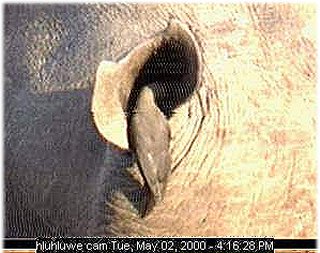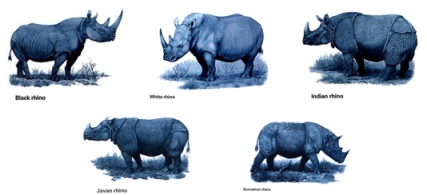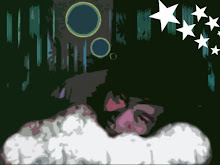Like the extinct dinosaurs 70 million years ago, the rhinoceros is the sixty million years ago there were 30 species that live on the earth also suffered extinction. At this time only 5 species of rhinoceros in the world live among 3 types of rhinos live in Asia, namely: Badak Sumatera (Sumatran rhino) horned two or Dicerorhinus sumatrensis Fischer, the Javan rhino (Javan rhino) or one-horned Rhinocerus sondaicus Desmarest, Indian Rhinoceros (Indian rhino) or one-horned Rhinocerus unicornis Linnaeus.
HISTORY BADAK :
Rhino appeared in Tertiary times (± 65 million years ago) and consists of 5 periods:
Paleocene period (± 60 to 50 million years ago)
Eocene period (± 50 to 45 million years ago
Oligocene period (± 35 - 25 million years ago)
Miocene period (± 25 - 10 juta years ago
Pleocene period (± 10 million years ago)
Like the extinct dinosaurs 70 million years ago, the rhinoceros is the sixty million years ago there were 30 species that live on the earth also suffered extinction. At this time only 5 species of rhinoceros in the world live among 3 types of rhinoceros lived in Asia, namely:
* Rhino Sumatera (Sumatran rhino) horned two or Dicerorhinus sumatrensis Fischer, 1814
* Javan Rhino (Javan rhino) or one-horned Rhinocerus sondaicus Desmarest, 1822
* Indian Rhinoceros (Indian rhino) or one-horned Rhinocerus unicornis Linnaeus, 1758
And 2 types of rhinos live in Africa, namely:
1. African Black-horned rhinoceros horn (Black Rhino) or Diceros bicormis
2. African White-horned rhinoceros two (White Rhino) or maximum Cerathoterium
CLASSIFICATION BADAK
Javan Rhino
Rhinoceros is odd hoofed animals (perrisodactyla), in the year 1758 Linnaeus gave the clan name (genus) to the rhino Rhinoceros Java. Javan taxonomically classified as follows:
Kingdom: Animalia
Phylum: Chordata
Sub-phylum: Vertebrata
Super class: Gnatostomata
Class: Mammalia
Super Order: Mesaxonia
Order: Perissodactyla
Super family: Rhinocerotides
Family: Rhinocerotidae
Genus: Rhinoceros Linnaeus, 1758
Species: Rhinoceros sondaicus Desmarest, 1822
Rhinoceros: derived from the Greek rhino, meaning "nose" and ceros, meaning "horn" sondaicus: refers to the Sunda Islands in Indonesia. (Latin-icus indicate the location); "Sundanese" means "Java"
Sumatran rhinoceros
Asian rhino horn two later by Fischer (1814) given the scientific name of Rhinoceros sumatrensis (sumatranus), with various names synonyms: Ceratorhinus sumatrensis (sumatranus), Didermocerus sumatrensis (sumatranus), Ceratorhinus crosii, Rhinoceros crosii, Ceratorhinus lasiotis, Ceratorhinus niger, Ceratorhinus blythii. Classification and distribution sub-species can be distinguished into:
1. Dicerorhinus sumatrensis sumatrensis (Fischer 1814), with the spread of Sumatra, Malaysia, and Thailand.
2. Dicerorhinus sumatrensis harrissoni (Groves 1965), with the spread of Borneo.
3. Dicerorhinus sumatrensis lasiotis (Buckland 1872), with the spread of northern Burma to Assam and eastern Pakistan.
Dicerorhinus: derived from the Greek that is in, meaning "two"; CERO, meaning "horn" and rhinus, meaning "nose" sumatrensis: refers to the island of Sumatra (plus suffix ensis according to the Latin, meaning location)
MORFOLOGI BADAK
Javan Rhino
* Height of the soles of the feet to shoulder ranges from 168-175 cm.
* The length of the body from tip of snout to tail length of 392 cm and 70 cm in the head.
* Weight body can reach 1280 kg.
* Hairless body except the ears and tail dibagian.
* He wrapped a thick skin between 25-30 mm.
* Outer skin has a mosaic pattern.
* Folds of skin under the neck to the top of the border with shoulder.
* On the back there is also a form of skin folds of the saddle (saddle) and there are other folds near the top of the tail and hind legs.
* The female rhino has no horns, horn size can reach 27 cm.
* Color horns dark gray or black, the color darker the older, darker at the base than at its end.
Sumatran rhinoceros
1. Sumatran rhinoceros is the smallest rhino and the most primitive type of five species of rhinoceros that still live in the world.
2. His body was covered with short hair and rarely sized, so often called living fossils or primitive rhinoceros.
3. Sumatran rhino high measured from the soles of the feet to shoulder between 120-135 cm in length from mouth to base of tail between 240-270 cm.
4. Body weight can reach 909 kg.
5. Her body was plump and quite round, smooth skin and hair often, draw attention to the existence of two major skin folds.
6. The first fold around the thigh between the front legs, and a second fold on the abdomen and the lateral part.
7. In the body there are no creases, folds of skin so evident near the hind legs and fold the front culanya close second.
8. Horn the front (anterior) at the end of the muzzle is much greater than the rear horn (pasterior).
9. Horn is located on the back of the eye and often just a lump that is not greater in size than the front horn.
HABITAT BADAK
Rhinoceros habitat is lowland rain forest and the swamp (Tropical Rainforest and mountain moss forest), some found at an altitude of 1000 m above sea level.
Javan Rhino
1. The Javan Rhino is in the western region of Java island, exactly in Ujung Kulon National Park.
2. Places overgrown with bushes and shrubs of the meeting and avoid places that are open, especially during the day.
3. Shady forests and meetings, as well as the formation popular langkap rhino for shelter and refuge from the human pursuit.
4. Cruising areas for female rhino estimated 10-20 rhinos km2 and for males is estimated about 30 km2.
Sumatran rhinoceros
1. Living in inundated areas above sea level to high mountain areas (can also reach a height of more than 2000 meters above sea level).
2. Place to live that are important to him is enough food, water, shelter and prefer dense forest.
3. On the sunny weather is often down to the low-lying areas, to find a dry place. In hot weather found in the woods on a hilltop near a waterfall. Good to eat in the area of secondary forest.
4. Sumatran rhino habitat in Gunung Leuser, restricted to primary forests at an altitude between 1000-2000 meters above sea level.
POPULATION BADAK
Javan Rhino
In Indonesia, the Javan previously estimated spread on the island of Sumatra and Java. At that time Sumatra Javan spread in Aceh to Lampung. In Java, Java rhinoceros once widespread throughout Java. The Javan Rhino is now only found in Ujung Kulon, Banten. Year 1833 was found in Wonosobo, 1834 at Nusakambangan, 1866 at Telaga Warna, 1867 in Mount Slamet, 1870 at Tangkuban Perahu, 1880 around Mount Gede Pangrango, 1881 in Mount Papandayan, 1897 in Mount Ceremai and in 1912 was found at around Kerawang area. Frank in 1934 and has shot a male Javan from KARANGNUNGGAL in Tasikmalaya, now stored in specimennya Bogor Zoological Museum. According to the last individual who is found outside of Ujung Kulon.
In the year 1910 as the Javan wild animals have been formally reserved by the Government of the Netherlands East Indies, so that in the year 1921 based on recommendations from The Netherlands Indies Society for Protection of Nature, Ujung Kulon, the government declared a nature reserve. This situation is still going on until the status changed to Ujung Kulon Wildlife Reserve under the management of the Forestry Department and National Park in 1982.
In Ujung Kulon rhino population in 1937 estimated there were 25 fish (10 males and 15 females), and in 1955 there were about 30-35 tail. In the year 1967 in Ujung Kulon first time the census was held that mention the Javan population is 21-28 tail.
Rhino population downs than the birth of a child, is also influenced by the hunt. After a tight control over the lives of rhinoceros, the Javan population continued to increase to approximately 45 fish in 1975.
Javan population according to the census until the year 1989 is estimated to live 52-62 tail. November 1999 census conducted ole TNUK and WWF estimated 47 to 53 tails.
Javan population census conducted by the Center TNUK, WWF - IP and YMR in 2001 estimated the number of rhino population ranges from 50 to 60 tails. The last census conducted in 2006 Hall TNUK estimated range of the Javan population is 20 to 27 tails.
Sumatran rhinoceros
Based on the Analysis of Population and Habitat viability (PHVA) 1993 Sumatran Rhinoceros, Sumatran rhino population in the Sumatran ranges between 215 -319 tail or down about 50% in the past 10 years. Previous population in the Sumatran rhinoceros of Sumatra island ranges between 400-700 tails. Most are in the area of Mount Kerinci Seblat (250-500 tail), Gunung Leuser (130-250 fish) and Bukit Barisan Selatan (25-60 fish). Some other unknown quantity in the area of Mount Patah, Mount Abong-Abong, Lesten-Lokop, Torgamba and Berbak.
In Kalimantan, a scattered population groups in the area of Sarawak, Sabah and Kalimantan, the central region. In Malaysia the number of Sumatran rhino population is estimated to range from 67-109 tails.
According to the IUCN / SSC - African and Asian Rhino Specialist Group in March 2001, the number of Sumatran rhinoceros population ranges approximately 300 tails and spread in Sumatra and the Malaya Borneo / Sumatra Sumatran Rhino ~ 250 tails and Borneo Sumatran Rhino ~ 50 tails.
Estimated number of Sumatran rhino population by Indonesian Rhino Conservation Program in 2001 in the working area of RPU is as follows: TNKS 5 to 7 tails with density (density) from 2500 to 3500 ha per cow rhinoceros, TNBBS 60 to 85 at a density of 850 to 1200 ha per cow rhinoceros, TNWK 30 to 40 fish at a density of 700 to 1000 ha per cow rhinoceros.
Field observations in 1997 to 2004, RPU - PKBI estimate the number of population in the Sumatran rhinoceros TNBBS ranges from 60 to 85 tails. While in TNWK ranged between 15 to 25 tails.
Yayasan Leuser RPU data in 2004 (in Outline Indonesian Rhinoceros Conservation Strategy 2005) shows the number of population in the Sumatran rhino survey RPU locations ranged from 60 to 80 tails.

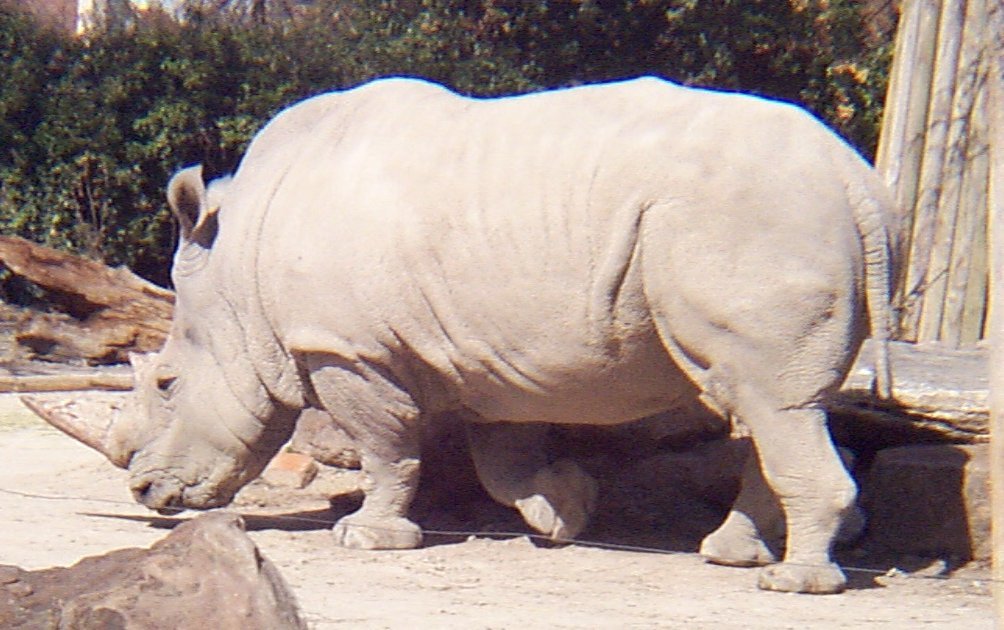
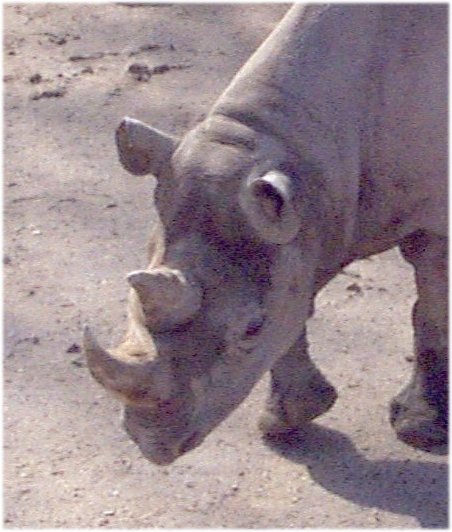 Black Rhinos; Height 1.5 - 1.75 meters at center of back, average weight 4,500 pounds. Body length up to 3.75 meters. Their color is brown; the tail is short. Although their eyesight is poor, both hearing and sense of smell are excellent. They have two large horns, the front one being the largest. These horns can measure up to 50 inches in length. The horn of all rhinos is formed of hair-like keratin fibers pressed together. The horns are found in both sexes. The upper lip is prehensile and helps the rhino browse through and manipulate foliage as it feeds.
Black Rhinos; Height 1.5 - 1.75 meters at center of back, average weight 4,500 pounds. Body length up to 3.75 meters. Their color is brown; the tail is short. Although their eyesight is poor, both hearing and sense of smell are excellent. They have two large horns, the front one being the largest. These horns can measure up to 50 inches in length. The horn of all rhinos is formed of hair-like keratin fibers pressed together. The horns are found in both sexes. The upper lip is prehensile and helps the rhino browse through and manipulate foliage as it feeds. 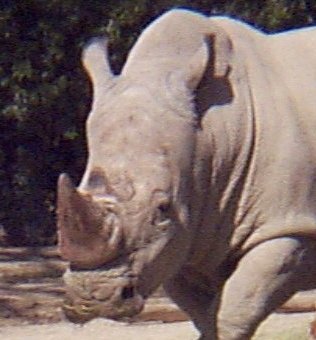

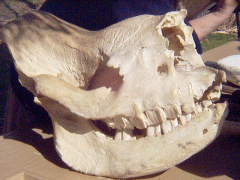 White / Black Rhino, Class Mammalia, Subclass Eupheria, Order Perissodactyla, Family Rhinocerotidae, Genus Cerathotherium / Diceros, Species Simum / Bicornis, Status Vulnerable.
White / Black Rhino, Class Mammalia, Subclass Eupheria, Order Perissodactyla, Family Rhinocerotidae, Genus Cerathotherium / Diceros, Species Simum / Bicornis, Status Vulnerable. 
